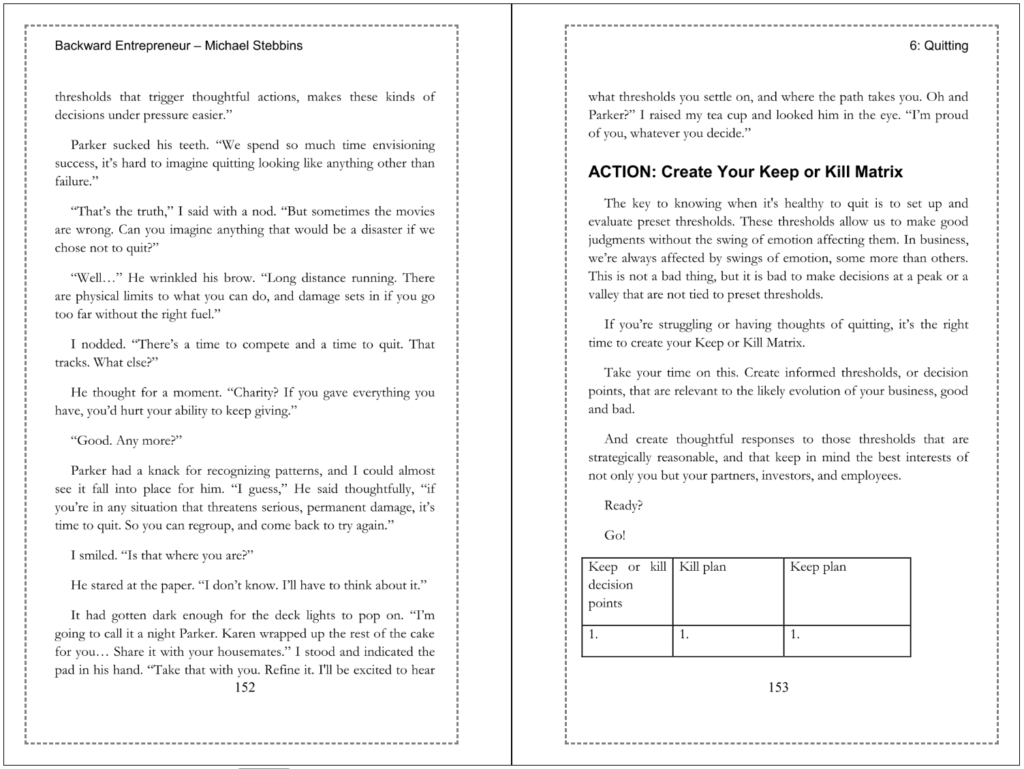Backward Entrepreneur – Go from idea to $20M on the shortest path
Released on July 20, 2023! Buy your copy here: https://mo.am/backwardentrepreneur
Praise for Backward Entrepreneur
“After reading Backward Entrepreneur cover to cover, I can promise it’s worth your time. The lessons this book shares aren’t just practical and accessible; they’re hard to find anywhere else. Michael keeps the actionable tips and cautionary tales coming, chapter after chapter, so you can design a great business without making the mistakes so many of us did. Founders need every advantage they can get—this book delivers.”
—Rand Fishkin, Author, Lost & Founder, CEO, SparkToro

“We have watched the principles in this book work time and again–and not just from the sidelines. We actively participated in Michael’s ventures, and advised the leaders as ideas turned into market-changing businesses.”
—Bryan & Jeffrey Eisenberg, NY Times Bestselling Authors of Call to Action, Waiting for Your Cat to Bark, Founders, Buyer Legends

“You should take my strong recommendation to buy this book because Michael has made me rich through two ventures with him! And, also because Michael makes the complex accessible, sharing specific solutions to a hundred little jobs you’ll have to do well, e.g., what to do when you approach a prospective buyer. Buy. Now.”
—Avinash Kaushik, Author, Web Analytics 2.0 (Wiley), Chief Strategy Officer, Croud

Backward?
John and I were sharing a folding table at one of our startups when he said, “You know … you tend to back into strategies.” I looked up from my laptop and commented with a smile, “That sounds like an insult.”
“On the contrary,” he replied, “It works very well, and it’s made us a lot of money. You should share it with others. You need to write a book.”
And he was right.
After building and selling multiple businesses, an odd pattern emerged. It turns out that much of the stuff taught in business-building books and MBA courses is useful, but unnecessary. Specifically, there are processes and decisions that can be eliminated or deferred until much better data is available. Others get mired with wasted time and expense too early, while the Backward Entrepreneur surges ahead using methods and timing shared in this book.
Chapter Preview
Chapter 1: Self Assessment – Are you Ready?
We establish self-awareness before investing heavily in entrepreneurship. (56 minute read)
Chapter 2: Ideas & Products
What separates entrepreneurs from dreamers: We have the ability to move what we imagine into reality. (43 minute read)
Chapter 3: Market Validation
The traditional entrepreneur seeks the biggest market and the capital to carve out some share. We know to start with the most sustainable market. (38 minute read)
Chapter 4: Vision, Mission, and Other Guiding Statements
We know when and how to use guiding statements. (23 minute read)
Chapter 5: Structuring the Business
We are faster than others, less inhibited, knowing when to make investments in infrastructure. (76 minute read)
Chapter 6: Quitting
We know when to quit and how to quit with the maximum benefit. (45 minute read)
Chapter 7: Getting Customers
When we ask, potential buyers reveal to us what will get them to buy. (65 minute read)
Chapter 8: Scaling The Business
If we can sell ten and make a profit, we know the path to sell 10,000. (90 minute read)
Chapter 9: Exiting the Business
We earn the biggest payouts by being considerate of others. (55 minute read)
Chapter 10: Generosity and Helping Others
How generosity wins in the long run. Wise actions after the sale (15 minute read)
About the Author
Growing companies: I have taken multiple companies from bootstrap to high-multiple acquisitions spanning e-commerce, digital marketing tools, industry standards, and digital marketing curriculum for agencies and universities.

Disruption and vision: As CEO and co-founder of Market Motive (acquired by Simplilearn), my team and I changed the way the world learns digital marketing. At ClickTracks (Acquired by Lyris) we disrupted the digital analytics market, showing the world a new way to look at analytics. As CEO and co-founder of OMCP (Acquired by NISM), my team and I established the first and largest digital marketing standards body serving exams to tens of thousands of learners and accreditation for hundreds of universities worldwide.
Martech and innovation: In marketing technology, I was awarded the first patent for marketing automation lead scoring US 7698420 in 2010. I continue to code for marketing automation and dabble in machine learning. I won’t code for you, but the experience does enable a clearer vision of what is possible in data management, connectivity, and marketing automation.
Digital marketing: For over 18 years, I have practiced and presented effective digital marketing across multiple channels. As the the CEO and co-founder of industry standards body OMCP, I served (and continue to serve) the industry in establishing best practices in digital marketing covering marketing automation, digital advertising, SEO, social media, content marketing, analytics, and conversion. Today, OMCP standards are taught by over 1000 colleges, universities, and training institutions worldwide. I am a co-author of Digital Marketing Fundamentals (Wiley 2023) which was the #1 new release on Amazon in March 2023 for universities and marketers looking for authoritative practices in digital marketing.
What’s in the Book
In Backward Entrepreneur, I’m throwing aside the curtain and sharing real examples from my experience building multiple startups. And I’m presenting conversations I’ve had with real students, partners, investors, and customers — inspired by actual events, with the names changed to protect the innocent.
There are exercises for you to complete right in the book or in a journal. I’d recommend capturing your answers on your first pass, from the gut, and circling back around to refine them later.
This book is largely about growing a business from an idea to $20M in revenue, but the methods can apply to all sizes of businesses. It assumes you’ll be the CEO or sole proprietor, but you’ll also find it useful if you’re one of multiple founders or part of an executive team. Whether you’re starting an online business, an enterprise software company, a side hustle, a service-based business, or a brick-and-mortar storefront, you’ll find concepts here that will give you a distinct competitive advantage.
Excerpts
“Yep,” I said. “The challenge for most entrepreneurs and marketers is that they’re in love with what makes their product the best. But that can make getting a compelling message to the market tricky. I don’t have to tell you how much noise there is out there. Content, spam, ads, ad blockers. Plus people are working, commuting, paying bills, taking the kids to soccer practice, binge-watching. Even if you do a perfect job of identifying your prospects, getting their attention in the middle of all that is incredibly hard.”
“Aw man,” she said with a grin, “and here I thought it would be easy.”
“It can be if you can cut through the noise. The human brain is way more likely to sit up and take notice when it’s presented with something familiar or disturbing. If you can use that to get a prospect’s attention, then you can guide them to the knowledge they need to make an informed decision.”

The Customer-Driven Acquisition framework has been monumentally effective in getting customers for startups, mid-size businesses, and divisions at multi-billion-dollar market leaders. It defines the pillars of what we should say and do when we’re reaching out to potential customers. It helps us to share our expertise and provide value — as customers define it — so we can earn their trust. When buyers trust us, they will buy. Our sales increase, and we sustain our business.
Why isn’t quitting addressed in every business book and every business course? Because it isn’t popular.

In business, the tides in our favor come and go. And there are moments when it seems certain we won’t make it to one of the more pleasant exits we’ll discuss in Chapter 9. To prepare for those moments, however unlikely, it’s worth establishing two things for ourselves in advance of a final decision.
When to quit.
And how to quit.
I nodded. “You’re not wrong. It’s no fun realizing that just having good ideas isn’t enough. It’s no fun realizing that unique or even patentable ideas still may never get the resources, the other ‘atomic bonds’ they need to succeed. But it’s a dose of reality that shines a light on just how critical it is to assess which of your concepts has the best possible chance to succeed.” I pointed at the slide again.
“To select one idea, to the death of all others, in your pursuit of success.”



